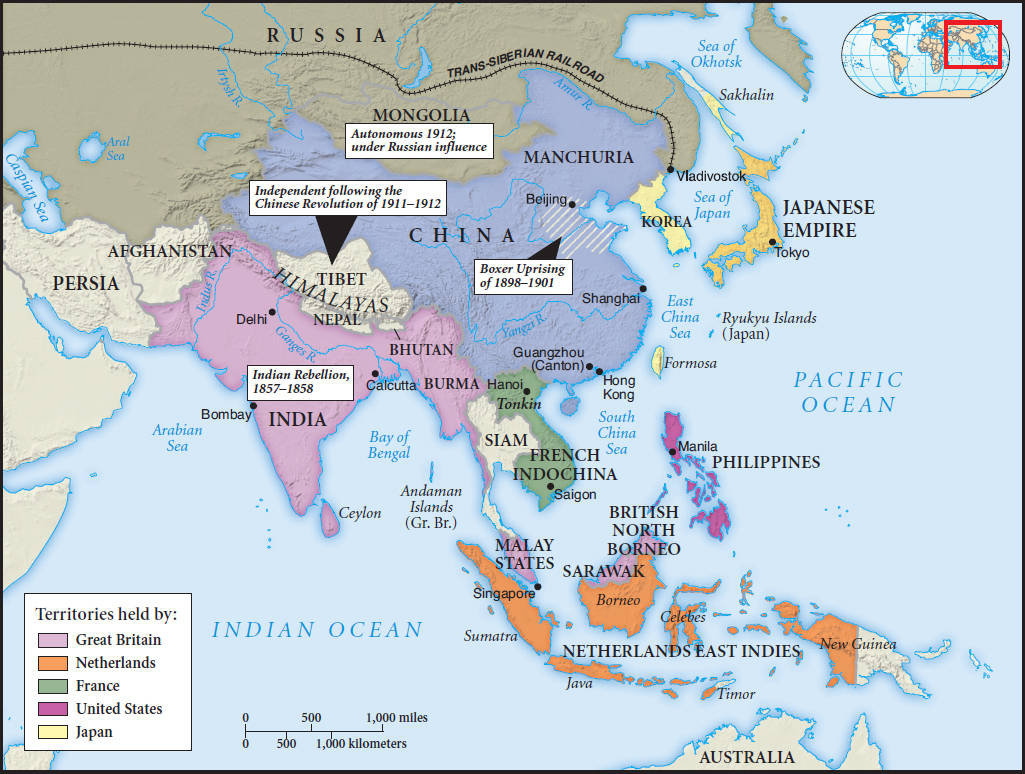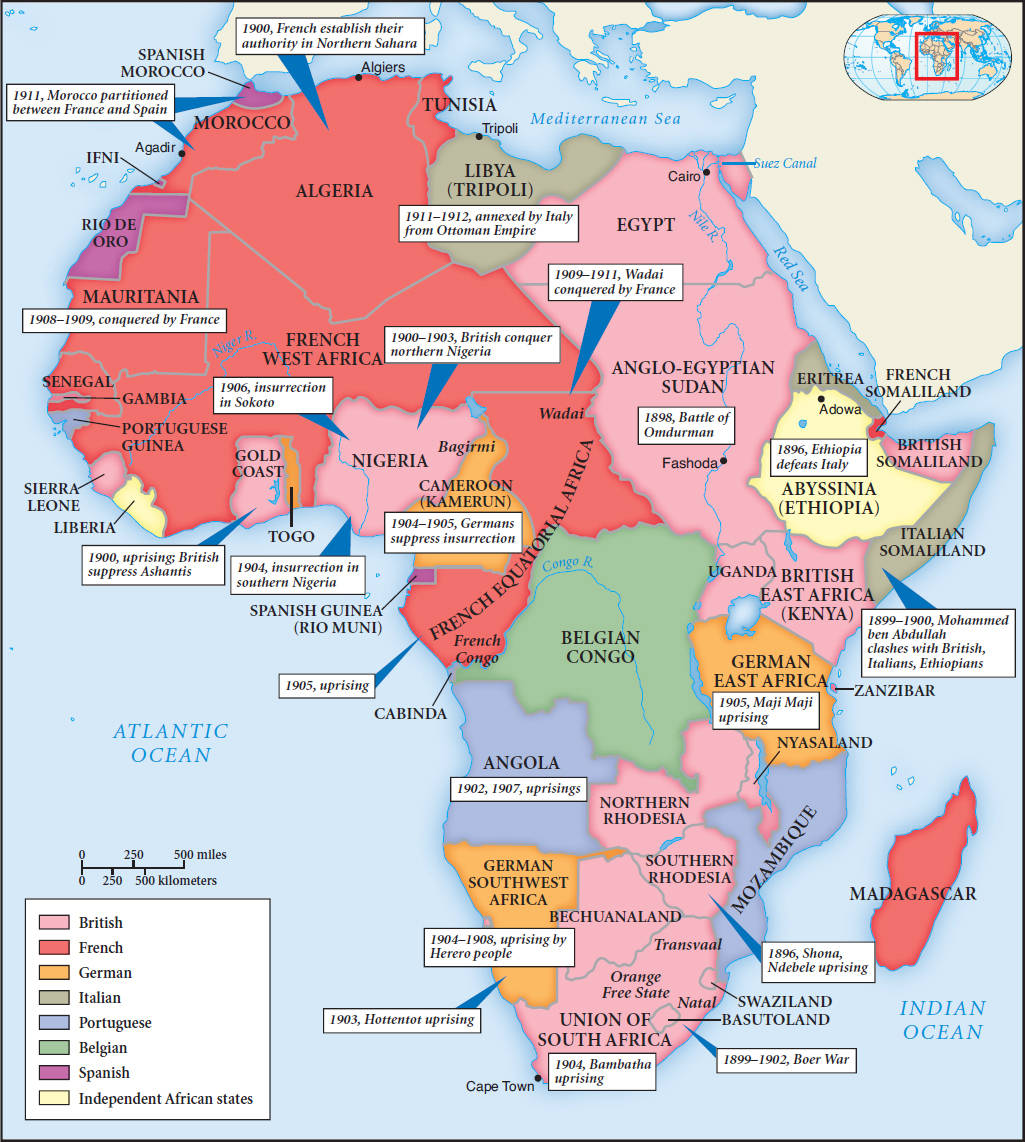A Second Wave of European Conquests
Comparison
Question
In what different ways was colonial rule established in various parts of Africa and Asia?
[Answer Question]
If the sixteenth- and seventeenth-century takeover of the Americas represented the first phase of European colonial conquests, the century and a half between 1750 and 1914 was a second and quite distinct round of that larger process. Now it was focused in Asia and Africa rather than in the Western Hemisphere. And it featured a number of new players—Germany, Italy, Belgium, the United States, and Japan—who were not at all involved in the earlier phase, while the Spanish and Portuguese now had only minor roles. In general, Europeans preferred informal control, which operated through economic penetration and occasional military intervention but without a wholesale colonial takeover. Such a course was cheaper and less likely to provoke wars. But where rivalry with other European states made it impossible or where local governments were unable or unwilling to cooperate, Europeans proved more than willing to undertake the expense and risk of conquest and outright colonial rule.
The construction of these new European empires in the Afro-Asian world, like empires everywhere, involved military force or the threat of it. Initially, the European military advantage lay in organization, drill and practice, and command structure. Increasingly in the nineteenth century, the Europeans also possessed overwhelming advantages in firepower, deriving from the recently invented repeating rifles and machine guns. A much-quoted jingle by the English writer Hilaire Belloc summed up the situation:
Whatever happens we have got
The Maxim gun [an automatic machine gun] and they have not.
Nonetheless, Europeans had to fight, often long and hard, to create their new empires, as countless wars of conquest attest. In the end, though, they prevailed almost everywhere, largely against adversaries who did not have Maxim guns or in some cases any guns at all. Thus were African and Asian peoples of all kinds incorporated within one or another of the European empires. Gathering and hunting bands in Australia, agricultural village societies or chiefdoms on Pacific islands and in parts of Africa, pastoralists of the Sahara and Central Asia, residents of states large and small, and virtually everyone in the large and complex civilizations of India and Southeast Asia—all of them alike lost the political sovereignty and freedom of action they had previously exercised. For some, such as Hindus governed by the Muslim Mughal Empire, it was an exchange of one set of foreign rulers for another. But now all were subjects of a European colonial state.
The passage to colonial status occurred in various ways. For the peoples of India and Indonesia, colonial conquest grew out of earlier interaction with European trading firms. Particularly in India, the British East India Company, rather than the British government directly, played the leading role in the colonial takeover of South Asia. The fragmentation of the Mughal Empire and the absence of any overall sense of cultural or political unity both invited and facilitated European penetration. A similar situation of many small and rival states assisted the Dutch acquisition of Indonesia. However, neither the British nor the Dutch had a clear-cut plan for conquest. Rather it evolved slowly as local authorities and European traders made and unmade a variety of alliances over roughly a century in India (1750–1850). In Indonesia, a few areas held out until the early twentieth century (see Map 18.1).

For most of Africa, mainland Southeast Asia, and the Pacific islands, colonial conquest came later, in the second half of the nineteenth century, and rather more abruptly and deliberately than in India or Indonesia. The “scramble for Africa,” for example, pitted half a dozen European powers against one another as they partitioned the entire continent among themselves in only about twenty-five years (1875–1900). (See Visual Sources: The Scramble for Africa for various perspectives on the “scramble.”) European leaders themselves were surprised by the intensity of their rivalries and the speed with which they acquired huge territories, about which they knew very little (see Map 18.2).

That process involved endless but peaceful negotiations among the competing Great Powers about “who got what” and extensive and bloody military action, sometimes lasting decades, to make their control effective on the ground. It took the French sixteen years (1882–1898) to finally conquer the recently created West African empire led by Samori Toure. Among the most difficult to subdue were those decentralized societies without any formal state structure. In such cases, Europeans confronted no central authority with which they could negotiate or that they might decisively defeat. It was a matter of village-by-village conquest against extended resistance. As late as 1925, one British official commented on the process as it operated in central Nigeria: “I shall of course go on walloping them until they surrender. It’s a rather piteous sight watching a village being knocked to pieces and I wish there was some other way, but unfortunately there isn’t.”6 Another very difficult situation for the British lay in South Africa, where they were initially defeated by a Zulu army in 1879 at the Battle of Ishandlwana. And twenty years later in what became known as the Boer War (1899–1902), the Boers, white descendants of the earlier Dutch settlers in South Africa, fought bitterly for three years before succumbing to British forces. Perhaps the great disparity in military forces made the final outcome of European victory inevitable, but the conquest of Africa was intensely contested.
The South Pacific territories of Australia and New Zealand, both of which were taken over by the British during the nineteenth century, were more similar to the earlier colonization of North America than to contemporary patterns of Asian and African conquest. In both places, conquest was accompanied by large-scale European settlement and diseases that reduced native numbers by 75 percent or more by 1900. Like Canada and the United States, these became settler colonies, “neo-European” societies in the Pacific. Aboriginal Australians constituted only about 2.4 percent of their country’s population in the early twenty-first century, and the indigenous Maori comprised a minority of about 15 percent in New Zealand. With the exception of Hawaii, nowhere else in the nineteenth-century colonial world were existing populations so decimated and overwhelmed as they were in Australia and New Zealand. Unlike these remote areas, most of Africa and Asia shared with Europe a broadly similar disease environment and so were less susceptible to the pathogens of the conquerors.
Elsewhere other variations on the theme of imperial conquest unfolded. The westward expansion of the United States, for example, overwhelmed Native American populations and involved the country in an imperialist war with Mexico. Seeking territory for white settlement, the United States practiced a policy of removing, sometimes almost exterminating, Indian peoples. On the “reservations” to which they were confined and in boarding schools to which many of their children were removed, reformers sought to “civilize” the remaining Native Americans, eradicating tribal life and culture, under the slogan, “Kill the Indian and Save the Man.”
Japan’s takeover of Taiwan and Korea bore marked similarities to European actions, as that East Asian nation joined the imperialist club. Russian penetration of Central Asia brought additional millions under European control as the Russian Empire continued its earlier territorial expansion. Filipinos acquired new colonial rulers when the United States took over from Spain following the Spanish-American War of 1898. Some 13,000 freed U.S. slaves, seeking greater freedom than was possible at home, migrated to West Africa, where they became, ironically, a colonizing elite in the land they named Liberia. Ethiopia and Siam (Thailand) were notable for avoiding the colonization to which their neighbors succumbed. Those countries’ military and diplomatic skills, their willingness to make modest concessions to the Europeans, and the rivalries of the imperialists all contributed to these exceptions to the rule of colonial takeover in East Africa and Southeast Asia. Ethiopia, in fact, considerably expanded its own empire, even as it defeated Italy at the famous Battle of Adowa in 1896. (See Visual Source 18.5 for an account of Ethiopia’s defeat of Italian forces.)
These broad patterns of colonial conquest dissolved into thousands of separate encounters as Asian and African societies were confronted with decisions about how to respond to encroaching European power in the context of their local circumstances. Many initially sought to enlist Europeans in their own internal struggles for power or in their external rivalries with neighboring states or peoples. As pressures mounted and European demands escalated, some tried to play off imperial powers against one another, while others resorted to military action. Many societies were sharply divided between those who wanted to fight and those who believed that resistance was futile. After extended resistance against French aggression, the nineteenth-century Vietnamese emperor Tu Duc argued with those who wanted the struggle to go on:
Do you really wish to confront such a power with a pack of [our] cowardly soldiers? It would be like mounting an elephant’s head or caressing a tiger’s tail. . . . With what you presently have, do you really expect to dissolve the enemy’s rifles into air or chase his battleships into hell?7
Still others negotiated, attempting to preserve as much independence and power as possible. The rulers of the East African kingdom of Buganda, for example, saw opportunity in the British presence and negotiated an arrangement that substantially enlarged their state and personally benefited the kingdom’s elite class.